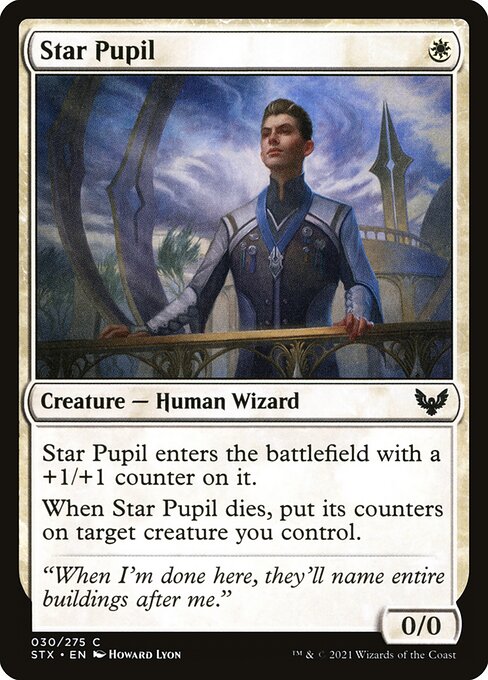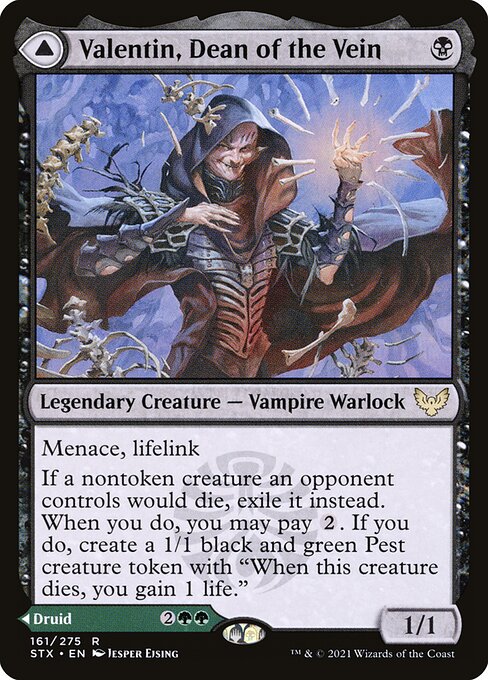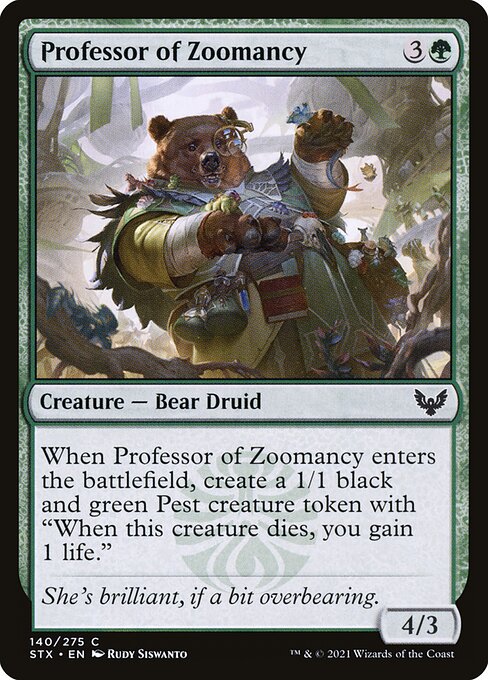With its Elder Dragons and rigid guild pairs, Strixhaven comes off as a quirky hybrid of Dragons of Tarkir and Ravnica. Those are relatively hard acts to follow, and I think we can agree that Strixhaven doesn’t hit the high marks of those blocks. While the Tarkir Elder Dragons were splashy, expensive, and the best things you could be doing in the color combination while in Standard, the Strixhaven Elder Dragons are a bit less thrilling.
Frankly, in every color (or in no color with Ugin, the Spirit Dragon around), there’s a more impactful card waiting in the wings to fill in the top-end, whether it’s Vorinclex, Monstrous Raider, Valki, God of Lies, Goldspan Dragon, Embercleave, Professor Onyx, or Dream Trawler. Nothing wrong with that—they’re still bombs in Limited and potentially interesting Commanders—but it does add to the mildly deflating affect of Strixhaven. I don’t think it’s a coincidence that Wizards juiced Strixhaven with Mystical Archives, which are essentially a “Masterpiece in every pack” experiment to drive up excitement.

But I didn’t come here to bury Strixhaven—I’ve been enjoying shooting the moon in Limited and going all-in on Mizzix’s Mastery or playing five copies of Star Pupil in silly Silverquill decks too much. What I want to do instead is a bit of future-crafting, highlighting the cards that went under-mentioned and -respected during spoilers. Strixhaven is a sleeper set, and it may remain sleeping until Innistrad rolls in—perhaps by design—but some of my favorite sets have been those that open up with time. Sometimes Magic needs to decant.
Wandering Archaic is my favorite card to see staring back at me from the back of a pack. He goes in every Limited deck, and I’m wondering if we can’t find a place for him in Standard, where there’s a secret Affinity deck. Forsaken Monument is a huge game if you can build a deck to suit it, and Ugin does what Ugin does, except he can’t touch your side of the board. I’ve been running a mono-colorless deck, and it gets run over by aggro, but the Archaic gives it a bit of resiliency.
Between Ugin, Stonecoil Serpent, Wandering Archaic, Crawling Barrens, Mazemind Tome, and various colorless lessons, including Mascot Exhibition, we have the core of something that’s pretty unique and worth running when you’re tired of the more accepted archetypes. I’d like a couple more pieces of payoff, but perhaps there will be some Eldrazi leftovers in one of our upcoming Innistrad sets.

Culling Ritual is a secret “free spell” along the lines of Frantic Search or Rewind. I’ve never seen it return less than three mana, and it sometimes serves as ramp. Against Cat-based Rakdos decks in Historic, it can undercut their entire strategy without slowing yours down. Culling Ritual went immediately into my Historic sideboard, and it’s a great counter against the Rootha, Mercurial Artist plus Elemental Masterpiece deck in Limited. I’ve seen it wheel, and that’s absurd. It wipes away Prismari Apprentice, Pests, Spirits, and Elementals, and does so for a net of zero to two mana.
Lorehold Excavation has won me several stalled-out games and has—in tandem with a second copy—lost me at least one to milling. It’s a truly unique card, and one whose power subtly changes over the course of a game. Lorehold can be difficult to get to work in Limited, but the Excavation gives it a lot of reach. The extra point or two of damage matters in the format.
This also means that I’ve been finding myself running Unwilling Ingredient more than I expected. Generally, I eschew one-drops in Limited, as they get outclassed so quickly and are such a dire topdeck, but the little one-drop Frog holds +1/+1 counters well and trades in for a card later in the game. Likewise, Eyetwitch has been an MVP, but both of these unassuming little guys are outclassed by Valentin, Dean of the Vein. Valentin is an Unwilling Ingredient with even more to offer, and he’s been impressing me consistently in Witherbloom decks or—more frequently—Silverquill decks, where he’s a must-kill threat with a couple of counters.

Valentin doesn’t seem like much on paper—Lisette is the more appealing card in a vacuum, with her square stats and life gain/+1/+1 counter payoff. Valentin just comes off as a Vampire Cutthroat with some trinket text. But after running him in Witherbloom decks—mostly for Lisette—in Limited, he’s impressed me. Valentin is the centerpiece of my Abzan Mutate deck—he’s a great Mutate base, with the added benefit of being a pre-sideboarded pseudo-hoser for graveyard decks. Kroxa is much less impressive as a two-mana oneshot discard effect, and Anax is effectively blanked by the unimposing Vampire. I’ve even been exploring him in Historic Vampires, where he powers up quickly with Sorin, Imperious Bloodlord, and can stifle sacrifice-based decks starting on turn one. It’s humbling to write a card off and then have it become one of your new favorites, but I didn’t give Valentin the respect he deserved.
There’s a fair amount of that going around since Wizards has gotten wordier with their cards. With Arena as the temporary primary way to play sanctioned Magic, and Strixhaven firmly in the “designing for Arena” mindset, it’s clear that blocks of text we’re seeing on modern cards is a function of variance reduction. Valentin is a decent card as a 1/1 with two abilities for one mana, with the opportunity to upgrade into a Lisette later in the game, but he’s also trains players to run counter cards to their opponents’ strategies. It’s rare that he makes a huge difference, but his exile ability is pure upside, even if I can count the number of times I’ve had the mana spare to generate a Pest (it’s three times).
We’re seeing more and more complex cards since Throne of Eldraine (even as the power level has been deliberately ramped down); I believe Wizards is trying to solve the issue of Best of One variance. The more a card does, even if it’s minor, the more a card can smooth games when you’re not sure what strategy your opponent has chosen. So we get cards like the Strixhaven Deans, or the multifacetedly hateful Questing Beast, or the Kaldheim Gods–Swiss army knife cards that do a little of everything and aren’t shameful cards to run in your maindeck, even if you’d be happier with them in the sideboard. This is also why we have Lessons—you can fill out a Lesson-based sideboard and run a couple of Learn cards in your deck and know you have access to a quasi-sideboard even in Best of One games.
Speaking of: obviously, most of the Lessons are fine Limited cards. I’m more likely to run Inkling Summoning or Introduction to Prophecy in my maindeck in Limited, and am always happy to pick up Emergent Evolution or Introduction to Annihilation for any sideboard. But I’ve been most impressed with Environmental Sciences: Lay of the Land has always been an unplayable fifteenth-pick (outside of outré five-color decks), but making it accessible to any deck with a tacked-on two life in a format where life gain matters has given it new functions.

I’m still getting a handle on Strixhaven Limited—I’ve had the most success viewing it as “Wedge” set—splashing a third color to my primary school pair. Quandrix with a black splash has been my best performer, meaning that the Campuses have continually climbed up my pick rankings. The ground tends to get clogged quickly in Strixhaven, with two Professor of Zoomancy staring at each other across the battlefield, so scrying for your outs is incredibly vital. More than anything, I’ve been impressed with how intricate Strixhaven is—it’s easy to draft a Witherbloom deck only to discover you have all your life gain enablers, and none of your payoffs, or that you’ve drafted Prismari and have no curve whatsoever, even though you have three Mentor’s Guidances.
Suitably, Strixhaven raises within me a similar anxiety to when I knew I was going to flunk a test—that creeping sense of “I didn’t prepare enough for this, or worse—I prepared with the wrong material.” It’s perfect for a “wizards’ college” set, and it ties the theme together—sometimes, you don’t realize the lessons you’ve learned don’t matter in a new context (e.g., you’ve drafted three copies of Hunt for Specimens and are getting steamrolled by Frost Tricksters), and sometimes you’re completely overprepared.
A lifelong resident of the Carolinas and a graduate of the University of North Carolina, Rob has played Magic since he picked a Darkling Stalker up off the soccer field at summer camp. He works for nonprofits as an educational strategies developer and, in his off-hours, enjoys writing fiction, playing games, and exploring new beers.

